Philosophy of Religion
Chapter 2. Religions of the World
Section 9 . Zoroastrainism

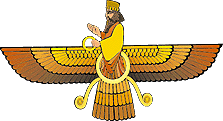
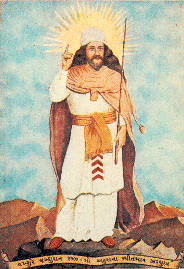
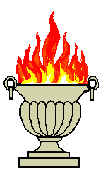
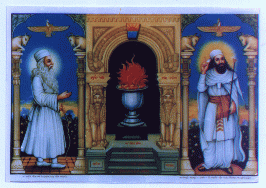

· THE ABSOLUTE: what do the believers hold as most important? What is the ultimate source of value and significance? For many, but not all religions, this is given some form of agency and portrayed as a deity (deities). It might be a concept or ideal as well as a figure.
· THE WORLD: What does the belief system say about the world? Its origin? its relation to the Absolute? Its future?
· HUMANS: Where do they come from? How do they fit into the general scheme of things? What is their destiny or future?
· THE PROBLEM FOR HUMANS: What is the principle problem for humans that they must learn to deal with and solve?
· THE SOLUTION FOR HUMANS: How are humans to solve or overcome the fundamental problems ?
· COMMUNITY AND ETHICS: What is the moral code as promulgated by the religion? What is the idea of community and how humans are to live with one another?
· AN INTERPRETATION OF HISTORY: Does the religion offer an explanation for events occurring in time? Is there a single linear history with time coming to an end or does time recycle? Is there a plan working itself out in time and detectable in the events of history?
· RITUALS AND SYMBOLS: What are the major rituals, holy days, garments, ceremonies and symbols?
· LIFE AFTER DEATH: What is the explanation given for what occurs after death? Does he religion support a belief in souls or spirits which survive the death of the body? What is the belief in what occurs afterwards? Is there a resurrection of the body? Reincarnation? Dissolution? Extinction?
· RELATIONSHIP TO OTHER RELIGIONS: What is the prescribed manner in which believers are to regard other religions and the followers of other religions?
**********************************************************
For those who wish to listen to information on the world's
religions here is a listing of PODCASTS on RELIGIONS by Cynthia
Eller.
If you have iTunes on your computer just click and you will be led to the
listings.
http://phobos.apple.com/WebObjects/MZStore.woa/wa/viewPodcast?id=117762189&s=143441
Here is a link to the site for the textbook REVEALING WORLD RELIGIONS
related to which these podcasts were made.
http://thinkingstrings.com/Product/WR/index.html
************************************************************
A small religious community, which exists mostly in Mumbai, is Zoroastrianism. The follower is called Parsi because the religion arrived in India from Persia. This religion was established by Zarathustra in 6th or 7th century BC. The followers of this religion exiled from Iran in the 7th century AD. because of religious persecutions by the Muslims. They arrived in Gujarat region of India.
The Parsis believe in the existence of one invisible God. They believe that there is a continuous war between the good forces (forces of light) and the evil forces (forces of darkness). The good forces will win if people will do good deeds think good and speak well. God is represented in their temples through fire, which symbolizes light. The holiest place for them is the village of Udvada in Gujarat, India. The holy language of the Parsis is an ancient language spoken in Iran, Avesta. The Parsis believe that fire, water, air and earth are pure element to be preserved and therefore they do not cremate or bury their dead ones but leave them on high towers, specially built for this purpose, to be eaten by hawks and crows.
The Parsis are less then 0.02% of India's population but their contribution to India is much more than their proportion in India's population. Some Parsis were main figures in establishing the Indian Nationalist movement. They were the pioneers in establishing the modern Indian industry. The rich Parsi families contributed enormously to establish institutions of all kinds in India. Even today some of the bigger finance houses in India belong to followers of this religion.
©Aharon Daniel Israel 1999-2000
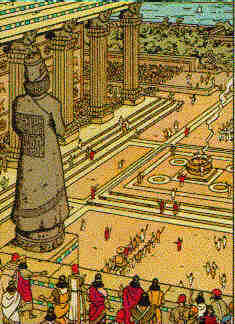
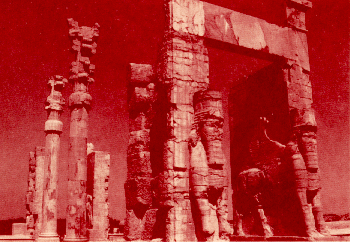
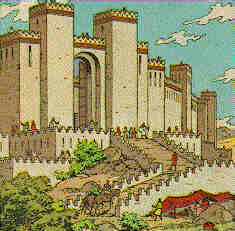
Zoroastrianism, religion founded in ancient Persia by the prophet Zoroaster. The doctrines preached by Zoroaster are preserved in his metrical Gathas (psalms), which form part of the sacred scripture known as the Avesta.
II. Tenets
The basic tenets of the Gathas consist of a monotheistic worship of Ahura Mazda (the "Lord Wisdom") and an ethical dualism opposing Truth (Asha) and Lie, which permeate the entire universe. All that is good derives from, and is supported by, Ahura Mazda's emanations: Spenta Mainyu (the "Holy Spirit" or "Incremental Spirit," a creative force) and his six assisting entities, Good Mind, Truth, Power, Devotion, Health, and Life. All evil is caused by the "twin" of Spenta Mainyu, who is Angra Mainyu (the "Fiendish Spirit"; Persian. Ahriman), and by his assistants. Angra Mainyu is evil by choice, having allied himself with Lie, whereas Spenta Mainyu has chosen Truth. So too, human beings must choose. Upon death each person's soul will be judged at the Bridge of Discrimination; the follower of Truth will cross and be led to paradise, and the adherents of Lie will fall into hell. All evil will eventually be eliminated on earth in an ordeal of fire and molten metal.
III. The Gathas and the Seven Chapters
The structural complexity of the Gathic scheme has best been explained by the assumption that Zoroaster amalgamated two religious systems. The first is outlined in the Gathas and is most probably Zoroaster's own; this is the monotheistic worship of Wisdom and his emanations (including Asha). The second, describing a cult worshiping a Lord (Ahura) who is custodian of Asha, is actually attested to in a portion of the Avesta, the Liturgy of the Seven Chapters, composed after Zoroaster's death in his own dialect. Zoroaster's teaching is praised and revered in the later section; its religious outlook, however, in part amalgamating earlier beliefs in Persia, is quite different from that of the Gathas. In the Seven Chapters, the emanations occur in the company of other sacred abstractions; Ahura has the epithet "possessing Asha," but Lie and Angra Mainyu are not mentioned. Many natural objects and mythical creatures, as well as ancestor spirits, are worshiped, and the very figure of Ahura Mazda resembles not so much Zoroaster's deity as the god Varuna (sometimes called the Asura, "Lord") of the most ancient Indian religious compositions, the Rig-Veda. See Veda.
The ancestors of the Persians (that is, the Aryan subgroup of the Indo-European peoples) and the invaders of northern India were of the same stock, and it may be assumed that they worshiped a number of similar deities. The Ahura of the Seven Chapters has wives, called Ahuranis, who, like Varuna's Varunanis, are rain clouds and waters. Ahura is possessor of Asha, as Varuna is custodian of Rta ("Truth" or "cosmic order" = Asha = Old Persian. Arta). The sun is the "eye" of both deities, and the name of Ahura is at times joined to that of the god Mithra. In the Veda, the names of Mithra and Varuna are similarly joined. The Seven Chapters also revere Haoma (Vedic, Soma), a divinized plant yielding an intoxicating juice (perhaps the "filth of intoxication" against which Zoroaster warned). The worship of ancestors and nature spirits and other deities (for example, the fire god, called Agni by the Hindus) likewise have Vedic correspondences. See also Hinduism.
IV. The Yasna and the Vendidad
The Gathas and the Seven Chapters form part of the larger liturgy called the Yasna, the remainder of which is composed in another, closely related, dialect. This material further illustrates the incorporation of the Aryan polytheistic paganism into Zoroastrianism, as do the linguistically similar Yashts, which are hymns to individual deities. Among these deities is Anahita, a fertility and river goddess probably borrowed (as was, perhaps, the custom of incestuous marriages) from the non-Aryan Elamites. The latest part of the Avesta, the Vendidad or Videvdat, was composed after the Greek conquest of Persia in the 4th century BC, and is mainly a codification of ritual and law, somewhat similar in tone to the Old Testament Book of Leviticus. It reflects those customs attributed by the Greek historian Herodotus to the Magi, a priestly caste of Median origin. These customs include exposure of corpses, protection of dogs, and the gleeful slaughter of crawling animals. The Avesta was composed in eastern Persia, as may be judged from its language and place-names.
V. Recognition and History
Probably the first Persian king to recognize the religion proposed by Zoroaster was Darius I. His inscriptions are full of the praises of Ahura Mazda; he stresses rationality and seems to regard Lie as a world force. His son, Xerxes I, was also a worshiper of Ahura Mazda, but he probably had less of an understanding of the details of Zoroaster's religion. Most striking is his conception that Arta will be attained in the afterlife, which view reflects the old Aryan idea that Rta has a location beyond the earth. Artaxerxes I (reigned 465-425 BC) was also a Mazda worshiper, but probably approved of a synthesis, under Magian direction, of Zoroaster's teachings with the older polytheism; this development is reflected in the syncretism of the Yashts. Artaxerxes II (reigned 409-358 BC) venerated Ahura Mazda, Mithra, and Anahita; in his reign the first Persian temples were probably built. Under the rule of the Greek Seleucids (312-64 BC) and Parthian Arsacids (250? BC-AD 224), cults of foreign gods flourished along with Zoroastrianism. The new Persian dynasty of the Sassanids (AD 224-651) established Zoroastrianism as the state religion of Persia. In the Sassanid theology, Ahriman was opposed to Ohrmuzd (Ahura Mazda), not to Spenta Mainyu. This theology had already appeared in the Magian system of the 4th century BC, according to Greek historians. Certain Sassanid theologians taught that Ohrmuzd and Ahriman were the twin sons of Infinite Time (Zervan), but this doctrine was eventually rejected.
Persia was gradually converted to Islam after its conquest by the Arabs in the 7th century. Zoroastrianism survived, however, in small communities of Gabars (a derogatory term coined by the Arabs) in the mountainous regions of Yezd and Kerman. About 18,000 still live in Iran. Zoroastrians, called Parsis (literally, Persians), are numerous and prosperous in India, chiefly in the vicinity of Bombay (now Mumbai). They still recite the Avestan liturgy and tend the sacred fires, but today they prepare a nonintoxicant "haoma," and few still follow the Magian doctrine of placing corpses on raised edifices (the so-called towers of silence) to be the prey of vultures.
| Special thanks to the Microsoft Corporation for their contribution to our site. The information above came from Microsoft Encarta. Here is a hyperlink to the Microsoft Encarta home page. http://www.encarta.msn.com |
SACRED TEXTS
Proceed to the next section by clicking here> next
© Copyright Philip A. Pecorino 2001. All Rights reserved.
Web Surfer's Caveat: These are class notes, intended to comment on readings and amplify class discussion. They should be read as such. They are not intended for publication or general distribution.